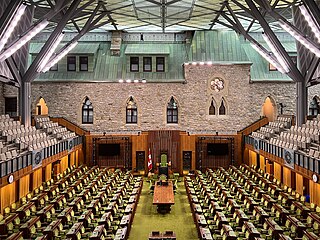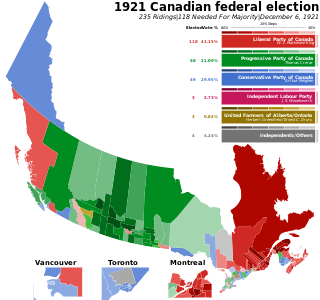
The House of Commons of Canada is the lower house of the Parliament of Canada. Together with the Crown and the Senate of Canada, they comprise the bicameral legislature of Canada.

The Progressive Conservative Party of Canada was a centre to centre-right federal political party in Canada that existed from 1942 to 2003.
A by-election, also known as a special election in the United States and the Philippines, a bye-election in Ireland, and a bypoll in India, is an election used to fill an office that has become vacant between general elections.

The 1921 Canadian federal election was held on December 6, 1921, to elect members of the House of Commons of Canada of the 14th Parliament of Canada. The Union government that had governed Canada through the First World War was defeated, and replaced by a Liberal government under the young leader William Lyon Mackenzie King. A new third party, the Progressive Party, won the second most seats in the election.

The 1872 Canadian federal election was held from July 20 to October 12, 1872, to elect members of the House of Commons of Canada of the 2nd Parliament of Canada. Prime Minister Sir John A. Macdonald's Conservative Party remained in power, defeating the Liberals. However, the Liberals increased their parliamentary representation considerably, while the Conservative seat count remained static, giving them only six more seats than the Liberals. The election produced the country's first minority government. The support of two independent Conservative MPs functionally gave Macdonald an extremely slim majority that allowed it to survive for two years, until it fell due to scandal.

An electoral district in Canada is a geographical constituency upon which Canada's representative democracy is based. It is officially known in Canadian French as a circonscription but frequently called a comté (county). In Canadian English it is also colloquially and more commonly known as a riding or constituency.

The 34th Canadian Parliament was in session from December 12, 1988, until September 8, 1993. The membership was set by the 1988 federal election on November 21, 1988, and it changed only somewhat due to resignations and by-elections until it was dissolved prior to the 1993 election.
Canada holds elections for legislatures or governments in several jurisdictions: for the federal (national) government, provincial and territorial governments, and municipal governments. Elections are also held for self-governing First Nations and for many other public and private organizations including corporations and trade unions. Municipal elections can also be held for both upper-tier and lower-tier governments.

The 1917 Canadian federal election was held on December 17, 1917, to elect members of the House of Commons of Canada of the 13th Parliament of Canada. Described by historian Michael Bliss as the "most bitter election in Canadian history", it was fought mainly over the issue of conscription. The election resulted in Prime Minister Sir Robert Borden's Unionist government elected with a strong majority and the largest percentage of the popular vote for any party in Canadian history.

The 1926 Canadian federal election was held on September 14, 1926, to elect members of the House of Commons of Canada of the 16th Parliament of Canada. The election was called after an event known as the King–Byng affair.

The 29th Canadian Parliament was in session from January 4, 1973, until May 9, 1974. The membership was set by the 1972 federal election on October 30, 1972, and it was dissolved prior to the 1974 election. It was controlled by a Liberal Party minority led by Prime Minister Pierre Trudeau and the 20th Canadian Ministry, with the support of David Lewis's New Democratic Party. The Official Opposition was the Progressive Conservative Party, led by Robert Stanfield. The Speaker was Lucien Lamoureux.

The 2nd Canadian Parliament was in session from March 5, 1873, until January 2, 1874. The membership was set by the 1872 federal election from July 20 to October 12, 1872, and it changed only somewhat due to resignations and by-elections until it was dissolved prior to the 1874 election. Among the by-elections were the first election of PEI MPs, PEI joining Confederation in 1873.

The 31st Canadian Parliament was a briefly lived parliament in session from October 9 until December 14, 1979. The membership was set by the 1979 federal election on May 22, 1979, and it was dissolved after the minority government of Joe Clark failed to pass a Motion of Confidence on December 13, 1979. The dissolution of parliament led to the 1980 federal election. Lasting only 66 days from first sitting to dissolution, and only nine months from election to election, the 31st was the shortest parliament in Canadian history.
From 1708 to 1926, members of parliament (MPs) of the House of Commons of Great Britain automatically vacated their seats when made ministers in government and had to successfully contest a by-election in order to rejoin the House; such ministerial by-elections were imported into the constitutions of several colonies of the British Empire, where they were likewise all abolished by the mid-20th century. The requirement of MPs to rejoin the House upon ministerial appointment arose from 17th-century ideas of the independence of the House from the influence of the Crown, which appoints the ministers. Unlike in the United States, whose constitution took such ideas to the extreme by fully separating the executive and legislative branches, support for some royal patronage meant that whilst MPs were barred from keeping their seats when made ministers, ministers holding an existing portfolio were not required to surrender their office when elected as an MP. This resulted in a compromise where newly-appointed ministers had to resign from the House, but could keep their office if they won a by-election back into it.
The Politics of Saskatchewan relate to the Canadian federal political system, along with the other Canadian provinces. Saskatchewan has a lieutenant-governor, who is the representative of the Crown in right of Saskatchewan; a premier—currently Scott Moe—leading the cabinet; and a legislative assembly. As of the most recent provincial election in 2020, the province is divided into 61 electoral districts, each of which elects a representative to the Legislature, who becomes their member, or MLA. In 2020, Moe's Saskatchewan Party was elected to a majority government. Regina is the provincial capital.
By-elections to the 35th Canadian Parliament were held to fill vacancies in the House of Commons of Canada between the 1993 federal election and the 1997 federal election. The Liberal Party of Canada led a majority government for the entirety of the 35th Canadian Parliament, with little change from by-elections.
By-elections to the 32nd Canadian Parliament were held to fill vacancies in the House of Commons of Canada between the 1980 federal election and the 1984 federal election. The Liberal Party of Canada led a majority government for the entirety of the 32nd Canadian Parliament, though their number did decrease from by-elections.
By-elections to the 28th Canadian Parliament were held to fill vacancies in the House of Commons of Canada between the 1968 federal election and the 1972 federal election. The Liberal Party of Canada led a majority government for the entirety of the 29th Canadian Parliament, though their number did decrease from by-elections.
By-elections to the 27th Canadian Parliament were held to fill vacancies in the House of Commons of Canada between the 1965 federal election and the 1968 federal election. The Liberal Party of Canada led a minority government for the entirety of the 27th Canadian Parliament, with little change from by-elections.